10+ Strategies To Get Sales On Shopify Without Paid Ads
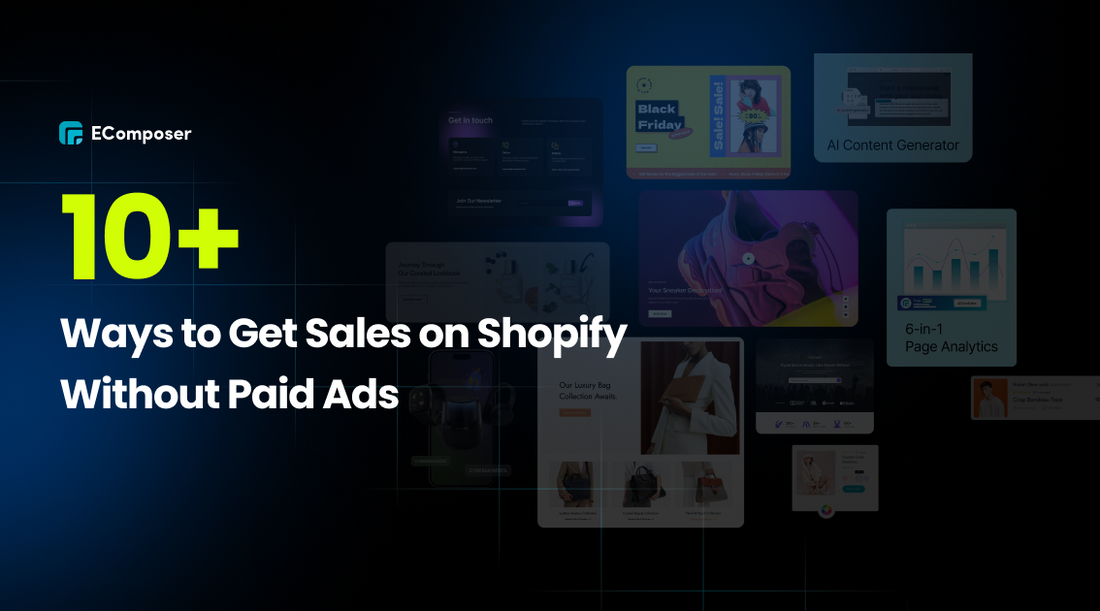
Table Of Contents
Getting sales on the Shopify store without paid ads and cultivating organic sales growth can be a sustainable and rewarding strategy for your Shopify store. This blog reveals 10+ effective ways to get Shopify sales, from designing your store to building a loyalty program without spending on ads.
Let's start!
1. Design An Attractive Product Page
In today's digital marketplace, capturing customer attention is more crucial than ever. And the battle for conversions often begins on your product page.
This part goes into great detail about how to create an appealing product page that not only showcases your products beautifully but also makes people want to click the desired "add to cart" button.
1.1. Write Compelling Product Descriptions
The startling revelation is that 87% of consumers can hold, feel, or even smell the product when shopping online, so thorough product descriptions are the most crucial factor. However, Baymard's study also reveals that 10% of websites fall short of expectations, leaving users perplexed or uncertain.
The good news is that you can create excellent descriptions without reading people's minds. Many customers only need to know the essentials such as:
Take inspiration from Sephora's product page. They have highlighted the value proposition to focus on specific aspects of the cosmetics product most relevant to a potential customer.

Sephora's product page.
Also, Sephora has a separate tab describing the cosmetic ingredients.
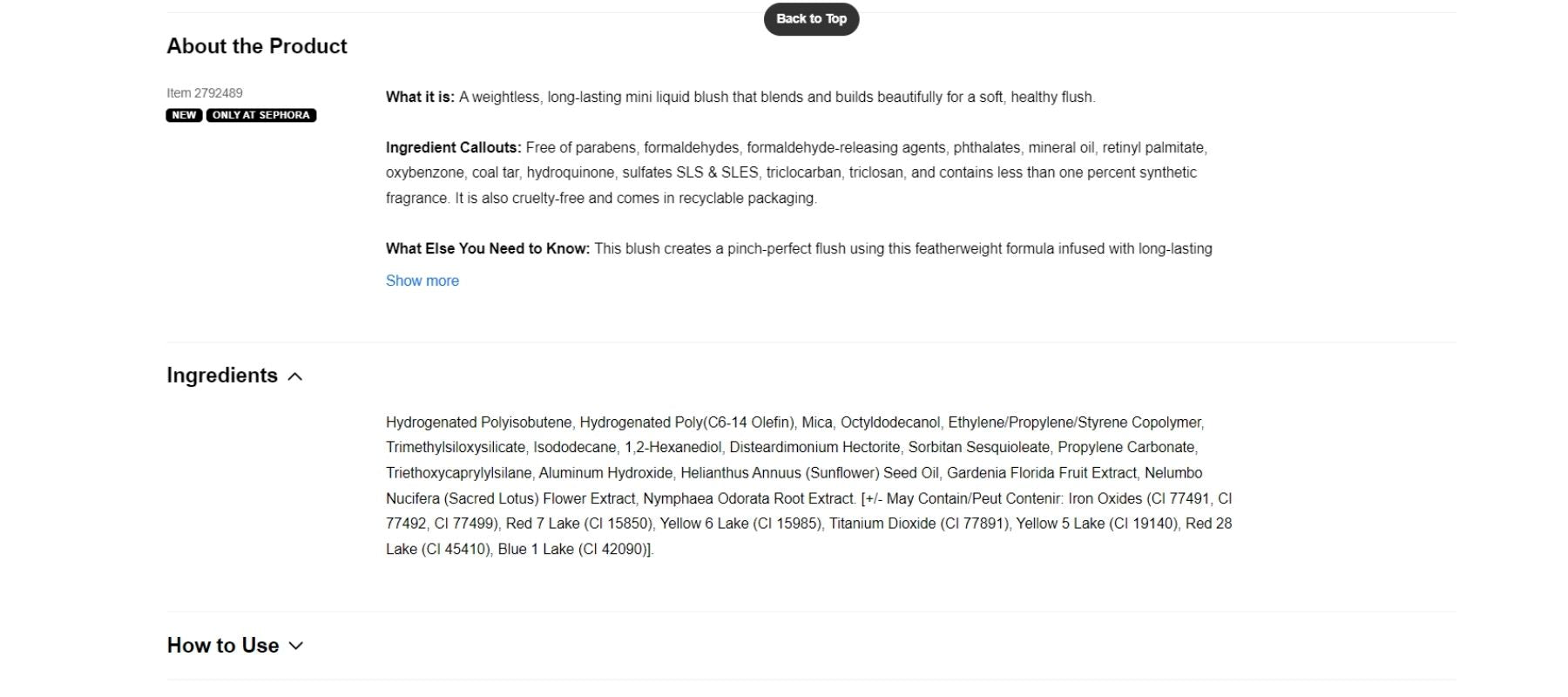
Sephora's ingredients tab on the product page.
The best part? Creating descriptions like this is easier than you think. In another tutorial, we'll show you how to add those extra tabs to Shopify product pages.
1.2. Use 3D/AR On Your Shopify Product Page
As we mentioned in the previous section, customers are worried when shopping online because they cannot hold and feel the product. In addition to writing traditional product descriptions, you can use augmented reality (AR) technology.
Take Sephora, for example. Their mobile app utilizes AR technology to allow you to try on different makeup looks from their extensive collection. Customers can experiment with various colors and styles to find the perfect look, all from the comfort of their home or in-store.

Sephora's AR technology.
Also, based on Shopify's case study, Gunner Kennels created 3D models of their crates using Shopify Plus. Gunner Kennels' return rate dropped 5% because purchasers could use mobile devices to put the kennel next to their dogs to validate size.
Read more: Instructions on how to add 3D models for Shopify Ecommerce.
1.3. Add Recent Sales Notification Popup
A recent sales notification popup is a small window on your website's user interface when a new consumer buys.

Explames of recent sales notification popup.
Although using recent sales notifications as social proof is not new, it is the most effective approach to increasing the fear of missing out (FOMO). It encourages speedy purchases, lowers cart abandonment rates, builds customer confidence, and boosts conversion rates.
We provide detailed instructions on how to add a sales notification popup (with video instructions).
1.4. Create An Effective Call-To-Action Button
A call to action is a crucial component of website design since it nudges visitors to take a certain action, like buying something or subscribing to a newsletter. Without a clear call to action, website visitors could depart without taking any intended action.
Take inspiration from Pura Vida, which simplifies adding items to a shopping cart.
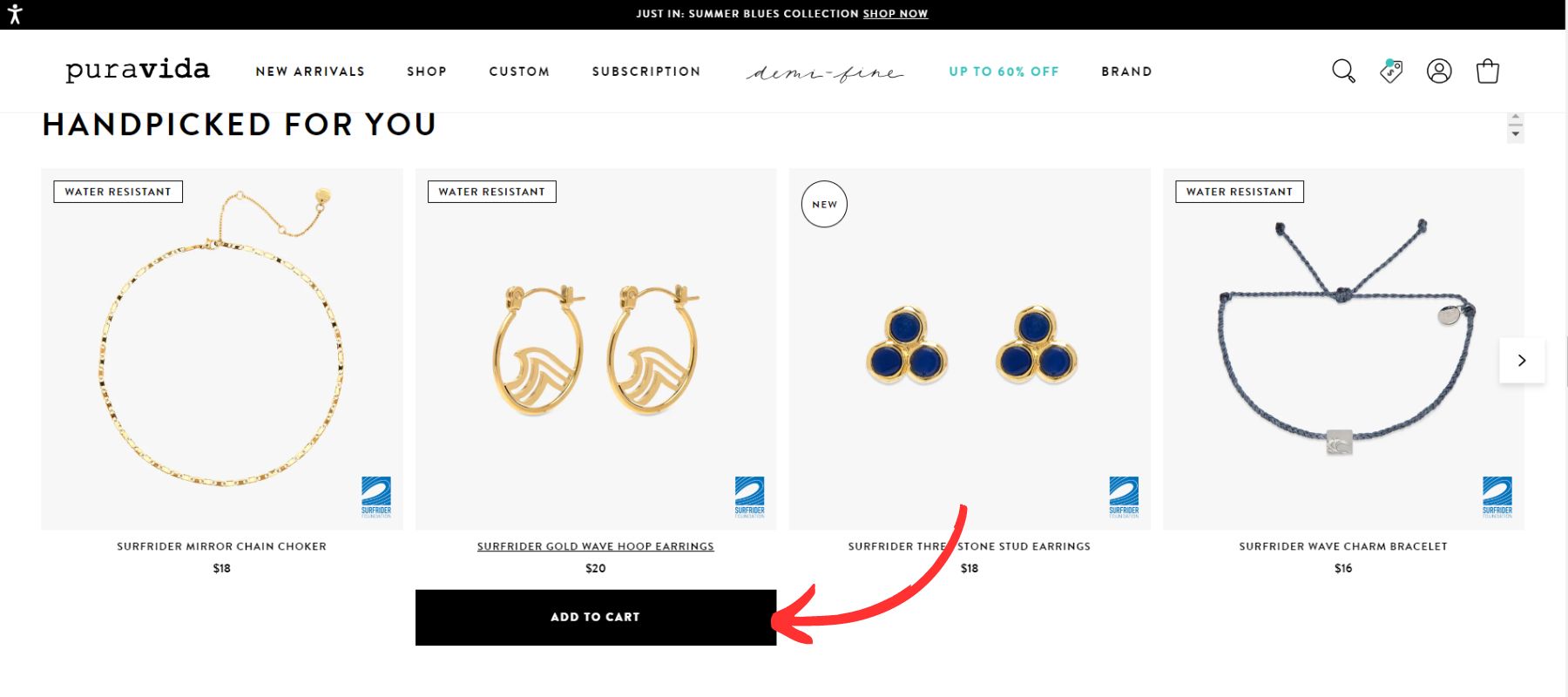
Pura Vida's homepage.
A visitor is likely to click and browse around your business if you can capture their interest above the fold. In newspapers, the most essential articles appear on the top half of the front page, which is folded on the newsstand.
In this instance, all the information that buyers want is shown on Dr. Squatch's site in the first scroll depth.

Dr. Squatch's product page.
However, designing a website button does not mean everybody will take the action you encourage. That's why you should include a well-crafted secondary CTA button.
For example, most online stores have the classic "Add to Cart" button, but they might also offer an "Add to List" option (Like ColorPop in the image below) for those who want to consider their options.

ColorPop's product page.
Secondary CTAs are designed to be a bit less flashy than their primary counterparts. They're there to offer an alternative action, even if most visitors ultimately take the action you originally hoped for.
The good news is that creating CTA buttons is easier than ever. Tools like EComposer Shopify Page Builder, with its drag-and-drop editor, make it a breeze. So go forth and design CTAs that get people clicking.

EComposer Builder Page.
Read more: How to increase the Add to Cart button font size?
1.5. Utilize Trust Badges
According to a Statista survey, 25% of users abandoned the checkout process because they didn't feel comfortable providing their credit card information to the website.
Although various things contributed to the development of trust, having trust badges on the website was crucial. The trust badges gave customers confidence that the website was reliable and safe.
For example, ASOS prominently displays its payment badges at the bottom of its webpage.

ASOS's website.
You can read the instructions on how to add trust badges to the Shopify footer.
EComposer Page Builder have a drag-and-drop editor that supports trust badge elements, making adding them to your Shopify store easy.

EComposer Builder Page's trust badge elements.
2. Clarify Shipping Costs And Return Policies
Did you know that surprise fees can be a real buzzkill for online shoppers? According to the Baymard Institute's research, nearly half (48%) ditch their shopping carts because unexpected shipping costs, taxes, or other fees leave a bad taste in their mouth. Another 18% of shoppers leave because a return policy seems unclear or restrictive.
That's why being crystal clear about your shipping costs and return policies is a game-changer.
Here are some ways to create transparent shipping costs:
- Differentiate between domestic and international shipping costs.
- Shipping options (e.g., standard, expedited, express) with estimated delivery times and corresponding costs for each.
- The free shipping threshold (Optional) above a certain purchase amount clearly states the minimum buy requirement for qualifying.
- You should include a real-time shipping cost calculator on your product pages. This will allow customers to estimate shipping costs before checkout, as Everlane does.

Everlane added a real-time shipping cost calculator on their product page.
Here are some ways to create clear return policies for your Shopify store:
- Create a dedicated webpage titled "Shipping & Returns" or something similar. Your website's footer and major navigation menus should make it simple for users to reach this page.
- Avoid using overly technical jargon. Explain your policies in clear, concise, and easy-to-understand language.
- Use bullet points, headings, and subheadings to break down the information and make it easier to scan and digest.
Also, you should create a Frequently Asked Questions (FAQ) section to address common customer inquiries about shipping and returns.
Read more: Guide to Creating a Helpful Shopify FAQ page.
Finally, in all order confirmation emails and marketing communications, include a link to your shipping and return policy page.
3. Optimize Your Shopify Store For Conversions
You've built a beautiful Shopify store - a testament to your brand and a virtual storefront brimming with potential. But, just like a well-designed brick-and-mortar store needs a strategic layout and clear signage to guide customers, your Shopify store requires optimization to turn those browsing visitors into loyal buyers.
In this section, we'll explore the ins and outs of conversion optimization, focusing on Shopify shops.
3.1. Mobile-First Design
According to a Google study, 50% of smartphone users would instead browse or purchase on a mobile website than download a mobile app.
That's why websites must adopt a mobile-first design strategy to stay competitive. The creation of a website that looks and works beautifully on smartphones and other mobile devices is given priority in mobile-first design, such as:
- Simple and clean layouts for readability.
- Large, easy-to-press buttons because fingers are less precise than mouse clicks.
- Optimized images to ensure images load quickly and are sized appropriately for mobile screens.
- Easy-to-read fonts that are large enough to read on small screens.
EComposer Builder Page offer drag-and-drop tools with mobile-friendly templates.

EComposer Builder Page mobile-friendly editor.
Read more: How to design a Mobile-Friendly Shopify Store?
3.2. Fast Loading Speeds
The two easiest ways to increase website speed:
Large picture files could slow down the loading speed of your website. You may minimize the size of your image files without compromising quality by optimizing them.
There are many approaches to this:
- Compress images using online tools and apps (like TinyPNG and Compress JPEG).
- Choose the correct format, as JPEG is the best for photos, while PNG is better for graphics with transparent backgrounds.
- Resize images to make sure your photos are no larger than needed.
Reduce HTTP Requests:
Whenever a file is loaded from your server (like an image, CSS, or JavaScript), it counts as an HTTP request. The more HTTP requests your website has, the slower it will load.
There are many strategies for lowering HTTP requests:
- Minify CSS and JavaScript removes unnecessary characters from the code, such as whitespace and comments.
- Combine files CSS or JavaScript files into a single file.
The blog article 10 Ways to Optimize Page Speed for Shopify Stores has more information on speeding up websites.
4. Upsell & Cross-Sell With Product Bundles, Volume Discounts
Businesses with the lowest churn rates cross-sell to one-third of their clientele. Marketing strategies like upselling and cross-selling aim to increase a customer's buy value.
You may use two powerful tools: product bundles and volume discounts.
4.1. Product Bundles
Product bundles combine many related products into one affordable package, sometimes at a reduced rate.
Hello Fresh, a well-known meal kit provider, is an example of pure product bundling. Customers of Hello Fresh do not buy individual meals. Instead, customers buy a meal package that can be customized to their food quantity and dietary requirements, and many meals are delivered.

Hello Fresh customized meal plan.
You can combine products that make sense and improve customers' shopping experience. Consider what items customer usually get in tandem or what may enhance their first buy.
For instance, combine a travel mug with a subscription to coffee bags or a phone cover with a screen protector.
Read more: How to Customize Shopify Product Recommendations?
4.2. Volume Discounts
One example of a volume discount is P&Co's "Buy 2 Get 1 Free On All T-Shirts" promotion. They offer a price break depending on the quantity bought to encourage consumers to buy more of the same product.
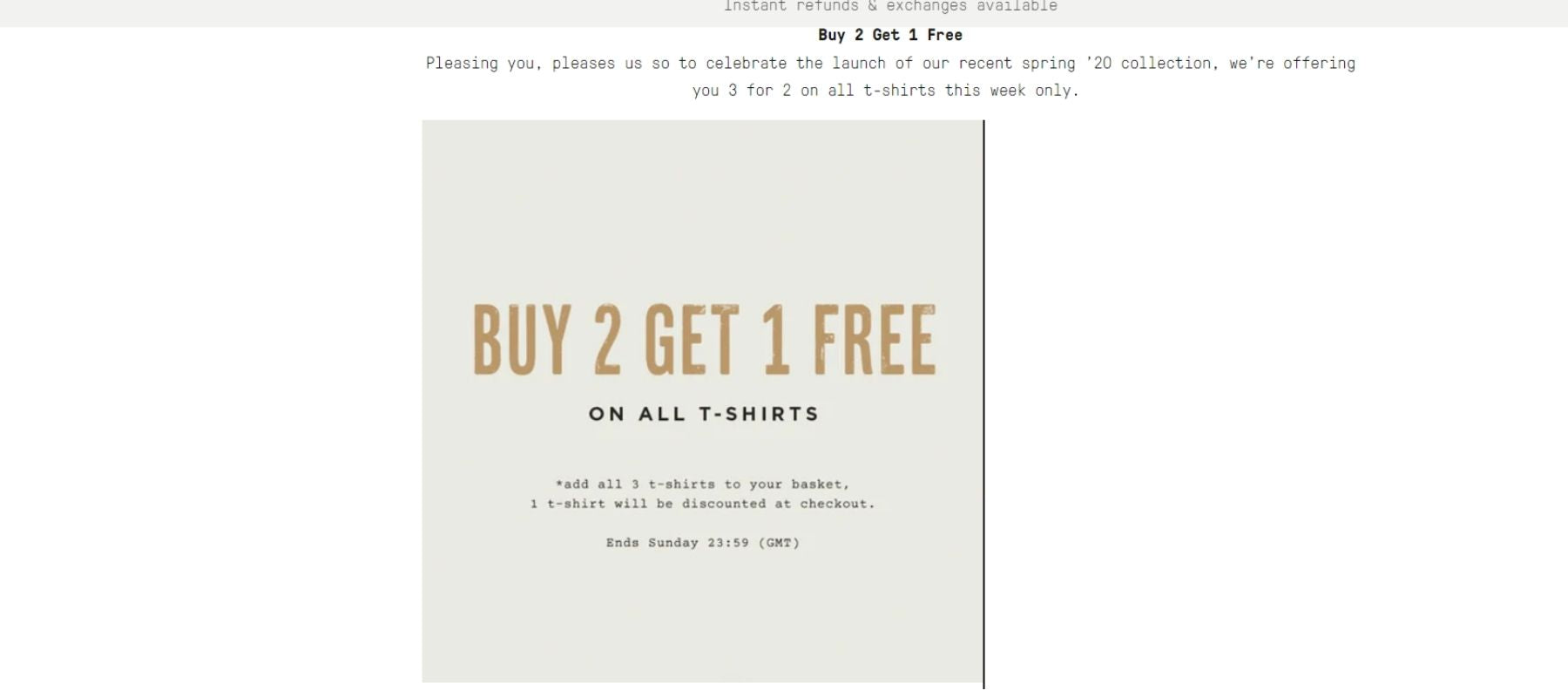
P&Co's "Buy 2 Get 1 Free On All T-Shirts" campaign.
However, not all products are created equal. When calculating volume discount percentages, consider each item's profit margin. You don't want to lose money when making large, deeply discounted purchases.
You can develop a tiered discount structure that rises with the buy amount. This encourages consumers to buy more for larger discounts.
If you don't know how to do it, consider using the EcomRise: Upsell & Cross-Sell app. EcomRise solutions may boost sales by developing Product bundles, Sales notifications (Sales popup), Volume discounts (Tier pricing), and Favicon cart count,...

EcomRise's features.
Explore more: 13 Top Shopify Bundle Apps.
5. Invest In Content Marketing And SEO
Paid advertising might give your Shopify shop a short lift, but building a devoted following via SEO (Search Engine Optimization) and content marketing gives you a long-term edge.
This section delves into the royal court of organic growth, where you'll learn how to leverage:
5.1. High-Quality Blog Content
Search engines like Google focus on websites offering up-to-date educational information. Regularly posting blog entries shows that your website is active and increases the likelihood that search engines will index it.
Stories make people feel emotional. To make your material better and more interesting, use visuals like pictures, graphs, videos, and story-telling methods.
Get inspired by Outland Denim's blog, which highlights their clothing sustainable fashion. They discuss their female employees, ethical production, and fashion industry successes and failures. This material emotionally engages their viewers and promotes their social impact goal.

Outland Denim's blog.
Find more ideas here:
High-quality blog content can attract backlinks from other websites. Backlinks are like votes of faith for search engines; they show how valuable and trustworthy your site is. If your website has a lot of backlinks, it is easier for people to find it.
5.2. SEO Optimization
It's not enough to write good, emotional blog posts. To truly maximize your reach, consider search engine optimization (SEO).
According to Google research, 53% of customers claim they always research to make the best decision possible before purchasing. That means the higher your website ranks, the more likely people will see it and click through.
SEO practices like keyword optimization, backlink building, and user experience improvements can influence your website's ranking in search results pages.
If you include appropriate phrases and keywords in your postings, search engines will have a better understanding of the content of your website. Customers are more likely to see your website in search results when they utilize these terms to find information.
This blog has more detailed instructions: Knowledge & Guide in Shopify SEO for Beginners.
6. Leverage Social Media
You need to use social media strategically to increase website traffic, sales, and brand recognition if you want your business to really take off. You will find the methods and resources in this area to help you transform your social media presence into an effective sales channel.
6.1. Run Contests And Giveaways
Social media giveaways and contests generate a lot of engagement. According to Tailwin's study, 91% of postings with more than 1,000 comments were freebies.
Here are some giveaway ideas to inspire your next campaign:
- Brand Partnership Bundle:
Team up with complementary brands your audience follows to create a reward bundle.
Get inspired by the collaborative giveaway between Ilia Beauty and Apparis on Instagram. The giveaway prize is a beauty balm set from Ilia Beauty and a winter coat from Apparis. To participate, like their post, follow Ilia Beauty and Apparis on Instagram and TikTok (@officialiliabeauty), and comment below.

Ilia Beauty's giveaway post.
- Mystery Box:
You can create excitement with a package full of unexpected goods relevant to your company, like Portland Leather does in the image below.

Portland Leather's giveaway post.
Give a reward to commemorate hitting a follower milestone. For example, give out a product package to commemorate gaining 10,000 followers.
Here are some of the best contest ideas for you:
For example, Gainda is a supplier of high-quality cleaning products. They held a Mother's Day contest on Instagram. Participants are asked to show off their house cleaning efforts to their mom using any Gainda Product and use the program's hashtags.

Gainda Mother's Day contest post.
- Creative Content Award:
Encourage your fans to share their creative works with your company, whether it's a picture or a commentary. Then, you may find content showing individuals utilizing your product, service, or place.
For instance, an athletic clothing brand would host a "Best Workout Selfie Contest," whereby participants could win a new outfit by sharing images of themselves using their items with an original remark.
6.2. Leverage User-Generated Content (UGC)
According to 81% of marketers, user-generated content connects with consumers better than influencer or professional picture material.
The idea behind using user-generated content (UGC) is to leverage fan or customer-generated content to market your product or brand. This content may include business-related blog articles, social media posts, pictures, videos, reviews, and more.
Take ideas from beverage brand LaCroix. They ran a fantastic campaign where fans snapped pics featuring their favorite LaCroix flavors and posted them to Instagram with the hashtag #livelacroix. The most eye-catching photos even got featured on LaCroix's official website.

LaCroix's website.
This campaign was a win-win. Participants got a chance to score some social cred (recognition from others online), and LaCroix got a ton of organic buzz (free promotion through word-of-mouth online sharing).
6.3. Shoppable Posts
Did you know 54% of social media users basically window shop online (research products) through their favorite social media apps?
That's where shoppable posts are like magic portals. It lets people discover products right there in their social media feed and buy them with just a few clicks without ever leaving the app.
Find the guide to selling on Instagram with Shopify here.
For ideas, check out this post from Glacelis, an art business. Their shoppable posts, which are part of a Mother's Day campaign, highlight various products that would be excellent gifts for moms.

Glacelis's shoppable posts on Instagram.
6.4. Influencer Partnerships
More and more brands and marketers are realizing the great effects influencer marketing can have. Let's look at the H&M brand's influencer marketing case study. They collaborated with four influencers. Each influencer posted a 10-second "teaser" clip and a 1-minute commercial on Twitter, Facebook, and Instagram. The image below is the result of customer interactions with the H&M brand:

Result of H&M brand's influencer marketing.
(Cite: cdn2.hubspot.net)
Also, a study by Taradel found that this effect makes people spend more. In fact, 94% of small businesses plan to raise their budgets in the next 12 months.
Here are some online platforms to find influencers for your Shopify store:
- Shopify Collabs is a free app that helps you find influencers on Instagram, YouTube, and TikTok. To identify the right match for your business, filter by audience demographics, follower numbers, and engagement metrics. Learn at: Set Up Shopify Collabs For Brands With 4 Easy Steps.
- Influencer marketplaces like Grin, Upfluence, and Neoreach connect brands with influencers across various niches. They offer advanced search filters and analytics to help you find the right influencer for your campaign.
Read more: 10 Top Shopify Influencer Apps for Brand Transformation.
You can also consider affiliate programs' strategies. Anyone can market your goods and earn a fee in exchange for sales. You can manage your partner program and keep track of results with tools like Refersion or ShareASale.
7. Create A Popup Form To Collect Email Customer
Great traffic is a good start, but website visitors aren't always ready to buy immediately. That doesn't mean you've lost them forever. Collecting email addresses can turn these visitors into potential future customers.
Many brands use popups and promotions to encourage email signups. For example, Birchbox, a beauty subscription service, uses exit-intent popups (those that appear when you move your cursor to leave the page) to offer a 20% discount in exchange for an email address.

Birchbox's popups.
This is a smart strategy - incentivize them to buy now. Also, combine it with email marketing that we provide in the following section.
8. Utilize Email Marketing Effectively
Effective email marketing is essential to any successful e-commerce strategy. Effective email marketing goes beyond just sending out newsletters; it also cultivates connections, increases brand loyalty, and eventually increases revenue.
In this part, we'll discuss how to make email marketing with case studies that connect with your customers and get results.
8.1. Welcome Emails
The most likely time for someone to connect with your message is after signing up or buying something. If a customer joins your email list, makes an account, or buys something on your website (especially a Shopify shop). Then, they will get a welcome email.
Entrepreneur's research found that welcome emails boost open rates by 86%. That suggests welcome emails have higher open and click-through rates than other marketing emails.
For example, Four Seasons Hotels and Resorts sent this personalized welcome email to a member named Marilia. They're grateful that Marilia signed up to hear about news, events, and special deals.
This email also talks about some great things about staying at a Four Seasons hotel, like staying at their newest locations and getting ideas from Four Seasons Magazine.

Four Seasons Hotels and Resorts's email
Without a doubt, welcome emails are like a warm hug for people who are new to your business. They set the tone for future contact and can be a strong way for people to love your brand and buy from you again.
8.2. Abandoned Cart Emails
Abandoned cart emails are like nice notes sent to website users who put things in their shopping cart but didn't finish the purchase.
Here's a typical structure of an abandoned cart email:
- Subject line: A catchy subject line to grab attention (e.g., "Did you forget something special?" or "We miss you - your cart awaits!").
- Friendly reminder: A gentle reminder about the items left in the cart.
- Visuals: Images of the products the customer abandoned can jog their memory and rekindle interest.
- Call to action (CTA): A clear button encouraging the customer to return to their cart and complete the purchase.
- Optional incentive: A discount code or special offer to sweeten the deal.

Examples of abandoned cart emails from ASOS.
8.3. Post-Purchase Emails
Post-purchase emails are automated emails sent to customers after they've completed a purchase on your website. They confirm the purchase details, including the items ordered, billing information, and expected delivery timeframe. They might also include a tracking number so the customer can follow their shipment.

Haoma Plants's post-purchase email.
Some post-purchase emails might suggest complementary products or recommend similar items the customer might be interested in. For subscription-based products or consumables, these emails can serve as gentle reminders to replenish their stock.
For example, Dollar Shave Club sends a monthly membership box replenishment email with cross-sell/upsell. Customers may add relevant goods to their boxes via email.

Dollar Shave Club's email.
Finally, post-purchase emails can include a polite request for the customer to share their feedback about their experience or the products they purchased.

After purchasing, Marriott Bonvoy emails consumers to rank their experience 1-10.
We will suggest a few tools that allow you to take advantage of AI in personalization email marketing in the next guide. Keep reading to find out!
9. Leverage AI And Automation
According to a McKinsey report in 2023, those clever robots we call AI (Artificial Intelligence) can automate 60% to 70% of the tasks people do at work these days. That's a big chunk of time that can be freed up for more strategic stuff. Pretty amazing, right?
We will suggest some AI tools in content creation for you:
- Jarvis (formerly Jarvis.ai) is an AI tool that utilizes brainstorming techniques to help generate creative content ideas. You can input keywords or a central theme, and Jarvis will suggest headlines, outlines, and even different content formats to explore.
- Copy.ai, a popular AI writing tool, generates social media articles, blog intros and outlines, product descriptions, and sales copy.
Here are some AI tools in email marketing personalization:
- Klaviyo is an email marketing platform that offers AI-powered features like product recommendations and abandoned cart recovery emails. It analyzes customer data to suggest relevant products and personalize email content for maximum impact.
- Mailchimp Subject Line Helper has a built-in feature within the popular email marketing platform Mailchimp; this tool analyzes your subject lines and offers suggestions for improvement based on character count, clarity, and engagement metrics.
- ActiveCampaign is an email marketing platform that utilizes AI to predict the optimal send time for each individual subscriber. This ensures your emails reach recipients when they're most likely to open and engage with the content.
These are some examples; however, the optimal AI tool for marketing depends on your budget, campaign objectives, and customization demands. When choosing, consider simplicity of use, scalability, and integration with your marketing tools.
10. Build A Loyalty Program
A recent Yotpo report shows the undeniable impact of loyalty programs. Over 83% of consumers report that reward programs influence their repurchasing behavior. In essence, loyalty programs generate organic word-of-mouth marketing, attracting new customers through existing satisfied ones.
Consider Blue Rose Pottery, a purveyor of exquisite, handcrafted pottery from Boleslawiec. They implemented a compelling rewards program leveraging Zinrelo's cutting-edge loyalty platform, aptly named "The Blue Rewards." This program fostered a stronger customer connection and increased 31.44% repeat purchase revenue.

Blue Rewards.
While the benefits are undeniable, crafting a successful loyalty program requires careful planning and ongoing optimization.
For a comprehensive guide on building and implementing a loyalty program, read on: How to Build A Loyalty Program?
Key Takeaways
You've learned a lot of natural ways to make sales that will help your Shopify store reach new heights. These methods will help you create a devoted consumer base and sales growth will eventually occur without paid advertising.
We encourage you to browse our blog for even more valuable insights into specific strategies or to explore additional tactics.


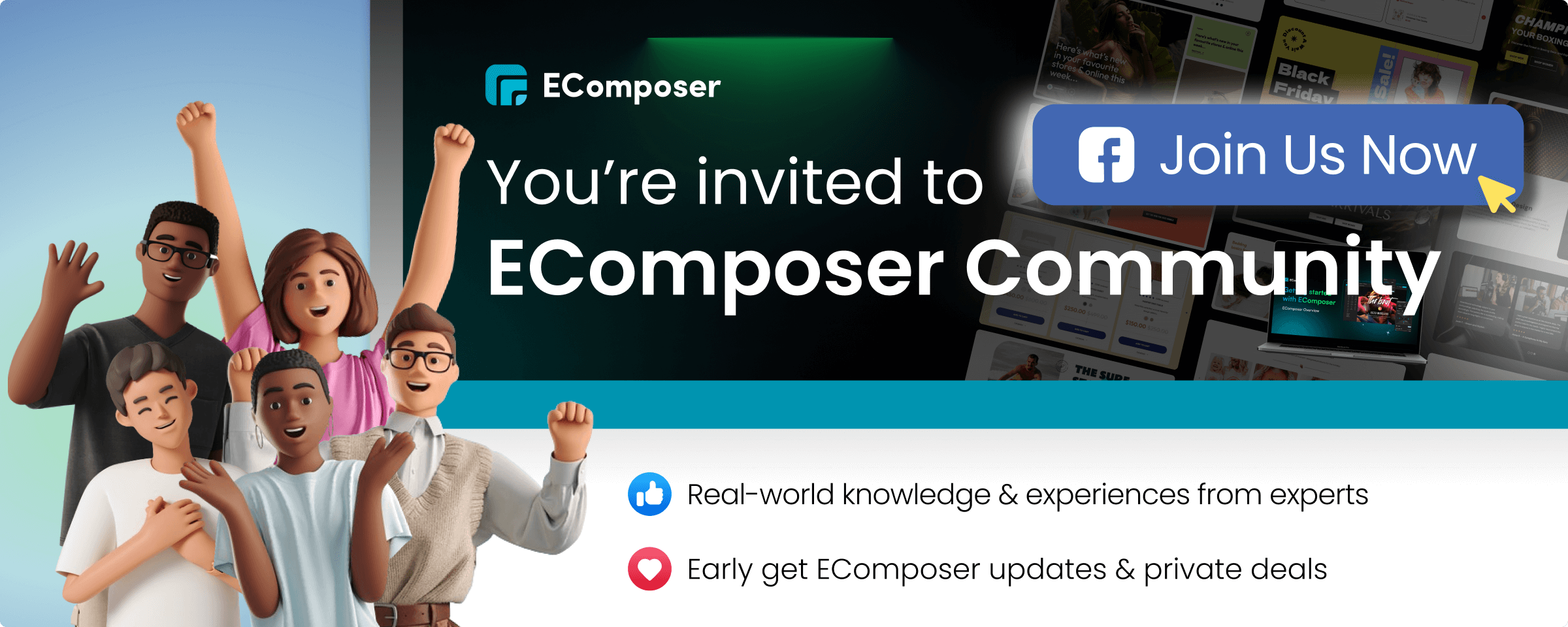



![[35+] Creative Mother’s Day Card Ideas to Melt Her Heart in 2025](http://ecomposer.io/cdn/shop/articles/image4_d9400c13-6375-4675-b58f-da78f15abcad_533x.png?v=1742463033)












0 comments